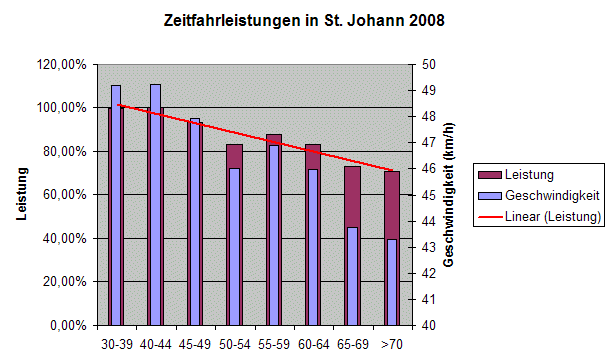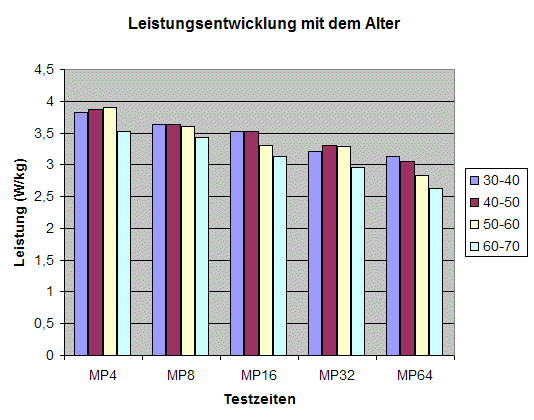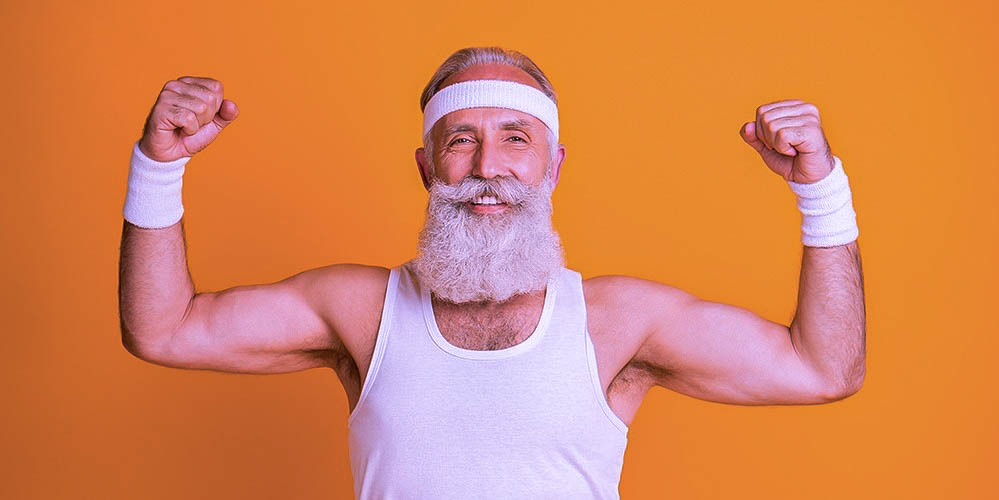Training through middle and old age keeps you unusually fit and resistant to social illnesses. All about training at advanced ages – what it does, how it works and where the limits are.
Watch at close quarters what grand-master racing cyclists (total age of the pair >100 yrs) manage in the Tour Transalp mountain marathon and you have to look on in disbelief. These graying gentlemen are still fast and resistant and gain lengths on most of the much younger competition. Somehow one imagines senior citizens differently.
Perhaps like the 70 or 80 year olds, who ride the Masters World Cup in St. Johann, Austria. At least you can see their age a bit. But even though the lines in the face are a little deeper, a 20 year-old, who hasn’t trained especially, or who isn’t exceptionally talented, finds it very hard riding against a 70 year old champion. In fact he doesn’t stand a chance. These old boys ride 43 km/h average in time trials. How many young sportsmen can do that?
So cycling appears to keep you young – or have they all just above average talent and managed to keep it going through life? To find answers, we have been searching in our archives, speaking to doctors and sportsmen and combing through data banks.
Positive Effects
Senior sportsmen in endurance sports are regarded by science as models of exemplary aging. Against the background of an aging population, sportsmen demonstrate what a difference an active lifestyle makes and are considered to be commendable in every respect. Instead of going regularly to the doctor, as do most of their contemporaries, to treat diseases of civilization – diabetes, high blood pressure and cardiovascular disease – they get on their bicycles and stay in good shape.
At 2PEAK there are 70+ year olds, like Rudi S.* (* name altered). He says about himself, “My motivation is better than ever, I am top fit and fully trained, weigh 70kg with a height of 1m83 (6ft 2in) and feel good.” He doesn’t need to prove anything to anyone, as he says, “I have ridden all the big marathons. Nowadays I ride long tours with a lot of climbing. But I enjoy it more; I ride with my 11 year old nephew and with my friend Jack, who is 80. On the hills, Jack comes to the front and we ride up with him at a sensible pace and are pleased to have an 80 year old with us.”
Endurance sports are regarded as good preventative measures for most of the diseases of civilization and are thought to help preventing cancer. Sports Doctor and specialist Dr. Karlheinz Zeilberger from München says, “The risk of heart disease for trained cycling athletes, compared to untrained people is lessened by 40-50%.” Sports can’t completely prevent illness, because there are risk factors, on which sport has no influence. You can still get heart or artery disease but the probability is lower and the quality of life higher for a person active in sport, especially as there is a social component to it, which transcends generations; as on training runs or meetings with kindred spirits.
The limits of performance at increasing age
What maximum efforts are possible at older ages? What effects are age-dependent, which depend upon training? To get to the root of this question researchers examined a very ambitious group – the world record holders.
Here they ought to be able to find out the effects of aging. The study, which was published in 2008 (Proc. R. Soc. Biological Sciences 276, S. 683) studied the Age world records in running up to 2007. It is easier to study running performance than cycling performance, because the times can be better translated into meaningful performance levels.
The main results can be applied to cycling however. The following illustration shows the study on the age world record holders between 40 and 90 years old. Maximum power falls by 30% between 40 and 70 – both in aerobic (endurance) sports and in anaerobic (sprint) events. This supports our analysis of time trial results by older cyclists in St Johann. The fall is pretty linear to this point. Past 70, the power fall off process is accelerated.

Researchers found that the balance between type 1 slow twitch muscle fibres and type 2 fast twitch fibres remained, though the total muscle mass was somewhat reduced.
The result is somewhat surprising, as many athletes have the feeling that they first lose speed, as did the 54 year old serial winner of the Tour Transalp – Max Pritzl, who has won the Grand Masters title 5 times: “I have been riding competitive cycling for 20 years, since I ruined my knee running. I haven’t noticed any deterioration in my performance – except perhaps in the speed. I think my endurance was at its highest level three years ago but mainly it is the time I need to spend on my career which prevents me from training more.” In a good year, Pritzl gets in around 20,000km.
Nevertheless, in the end it is the endurance which goes first, say the researchers. Once past 80, the sprinters have the advantage. World record for 100 meters for 90 year olds is an astounding 17.83 seconds.
There are indications, however, that at levels less than absolute world class standards, it is possible to maintain a good level. A survey by 2PEAK of 5,500 performance tests shows a more gradual decline of power with age.

Extended tests on master athletes show the effect of training (Journal of Applied Physiology, Vol 62, Nr. 2, P. 725): Through intensive training age class runners are almost able to maintain their VO2max level, whereas the control group, who trained less, showed a clear decline.
There are many reasons for the fall off in performance, but not all of them are clear in detail. Maximum oxygen intake (VO2max) is considered to be the most limiting factor. The deterioration in VO2max is, as is the drop in performance, around 1% per year. With increasing age, per decade the maximum pulse frequency drops (around 7-10 beats – although there are exceptions) the capacity of the heart drops by around 10% and also the difference in O2 solution level between arterial and venous blood decreases somewhat. The result of these factors is that less oxygen can be transported to the muscles, which affects the performance.
Training at older ages
What should senior athletes do differently from young ones regarding the above factors? “In principle nothing, as long as they stick to good training practice,” says Professor Norbert Bachl, director of the Austrian institute of sports medicine, who looks after athletes at all levels. “Athletes with no related illness or other risk factors, can train at maximum load and perform serious sport when over 60,” he specifies. Bachl explains, “that an increase in performance can only be achieved with high intensity training, which requires a solid basis of endurance training to be laid.” Prof. Bachl recommends an annual sports medical check-up, to avoid risks. This should include an EKG under load, blood pressure check under load and a blood test. A heart ultra sonic test is advisable, Bachl finds. The main problem he sees in older athletes is overconfidence and he advises a thorough warm up and drinking enough liquids.
The München specialist and sports doctor Karl-Heinz Zeilberger, who has been looking after top athletes for 20 years is a bit more cautious. He recommends older athletes to “reduce the amount of training in the red zone”. By this, he means training above the anaerobic threshold, especially high power efforts over some minutes, typical on short hills at full throttle. There is less of a problem with shorter sprints, as these load the muscles rather than the cardio-vascular system. In the anaerobic region, according to Zeilberger, „Stress hormones are released, which can increase the danger of heart rhythm disorder. Also anaerobic efforts at older age need a longer recovery period.” On the other hand, Zeilberger attests experienced older athletes as having a good feeling for their power levels: “They know exactly where their limits are and can thereby play with younger opposition.”
So in order to train by intensity, a diagnosis should first be made, to ascertain the training intensity zones and eliminate health risks. The resulting training plan should take into account the longer recovery time for senior athletes, whereby the individual training history plays a large role here. 2PEAK takes into account the training age when making training plans.
If you haven’t made any high intensity efforts for a long time, it would be better to do first in the presence of a sports doctor, rather than „wild”. Apart from anything else, it gives you the confidence to go for it without worries on the next hill. Important here is to make a genuine full power effort, because sometimes problems only become evident at the limit.
If you just want to perform sport for your health, you don’t actually need to go into the “red zone” – irrespective of age. It has to be said though, that the benefits of lower level training are less effective. Your power and also your health benefit from loading the body up to 80% of VO2max according to a further study in the Journal of Applied Physiology (2005, P 1619). At the higher training intensity, the time spent training is more efficiently used. Of course, this must be done with some common sense, and doesn’t mean going flat out every time you train. The level must be in related to the whole situation.
Late Starters
Endurance sport isn’t a secret science. You can start doing sport at 50 or 60. The body is well trainable at older ages, though the advantage which people have, who have been doing it all their lives, can never be caught up. But that is just a relative problem. The personal benefit is unarguable and it is possible to achieve around 20 years rejuvenation, at least as regards performance. From the medical standpoint, there is no age limit for endurance sport.
If you start with sport late in life, you should look for a training partner of around your level. Veterans who ride or go running with youngsters, soon find they have the same problem as women who train in a mixed group – they have to ride at too high an intensity, to stay with the group. That is why it is better to work on the basic endurance first with athletes of the same standard and to develop a feel for the correct intensity levels. Afterwards you can build up on this basis. You have to accept, that at 65 years old, you can’t compete with a trained 20 year-old. Mission impossible! Bill Palmer, 67, an ex-pilot who has been, with breaks, a competitive cyclist for 53 years, doesn’t find this a bad thing, “If I am in the bunch and the hammer goes down hard, I quickly have to decide who I am going to ride with, because I don’t have a chance of staying with the young cracks. So I compare my performance with my contemporaries and am actually more serious about racing than I was in younger years and train according to plan. Each season I find new aims, which thanks to being retired, I can go for.” As part of your training you should do compensating exercises such as trunk strengthening and exercises, to improve your mobility. Cycling is very healthy but is a rather one-sided. Older athletes especially should pay attention to these tips – which actually are just as valid for younger ones.
Perspective
You can’t turn back the clock – even with endurance sport. But you can reach a fantastic level of fitness with advancing age and keep this for a long time and improve the quality of life. A trained endurance athlete of 60 or 70 years revitalizes the term old rather! The gap between the fit and the unfit increases immensely with age. Doctors, this we know, would rather prescribe a bicycle for their patients. For the health of the population it would be a giant step forward. It could get a bit crowded on the roads though.
Training Tips for Older Riders
- Reduce the amount of anaerobic training (very hard efforts over several minutes).
- Plan 2 rest days a week.
- For optimum fitness and health load the body in moderation to the anaerobic threshold.
- Do compensating sport activity, strength training for the trunk.
Blog article: Relationship between Age and Race performance
Create a training plan for triathlon, cycling, and running based on artificial intelligence with 2PEAK that adapts to your performance after each training. Download the app and start revolutionizing your training.


